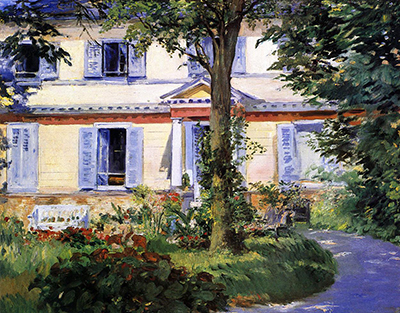In 1882, Manet painted an oil canvas measuring 92.8 x 73.5 cm of a house at Rueil. It’s difficult to believe that Manet was ill when he was painting this picture, and indeed he died within a year after completing this painting.
The canvas represents a front of a house at Rueil, in which Manet and his family were hosted for the summer of 1882 by Poet Eugene Lebiche. The painter was there to recover from a sickness he was suffering from, and he was depressed and hopeless when painting this image which is reflected in letters written during the time. Despite all these setbacks, Manet ensured his time was productive and in those letters he painted, he complained that inclement weather limited his painting activity and especially outside the house. Nevertheless, this canvas and many others from that time when he was ill, do not reflect emotional or physical inconsistency.
The size of this particular painting of the house at Rueil is relatively large, suggesting that Manet ambitions and means to achieve extensive work had not weakened. The work is also signed and dated which indicates that Manet considered it as finished. The canvas is handled with incredible enthusiasm and energy, particularly in the grassy clumps underneath the tree, in the greenery and the twisted pathway. The light in this particular painting is shining and bright and the view of the canvas is charged with liveliness and life.
Manet’s interest in the effects of light and colour was continually renewed as he took in the countless impersonations of incredibly diverse world around him. His portrayal of the house at Rueil belonging to his host, Eugene Labiche was by no mean intended as a faithful view. Manet instead focused on a section of the façade giving details much in a Japanese woodcuts style. It’s somehow impossible to paint the house as a whole because of the limited view and due to the tree trunk that deliberately cuts through the aedicule and hence through the useful and beautiful centre of the house, improving the viewer’s attention and appeal.
While the front of the house at Rueil is covered in raging sunlight, one can, however, sense the cooling shade provided by the top of the tree up above the upper part of the painting. It’s also easier to notice that there is a slight wind causing the patches of light to shift their position mildly. The house at Rueil canvas portrays Manet skills of balancing colours with the powerful contrasts of red and green and the controlled and the quality of tones of yellow and blue.




